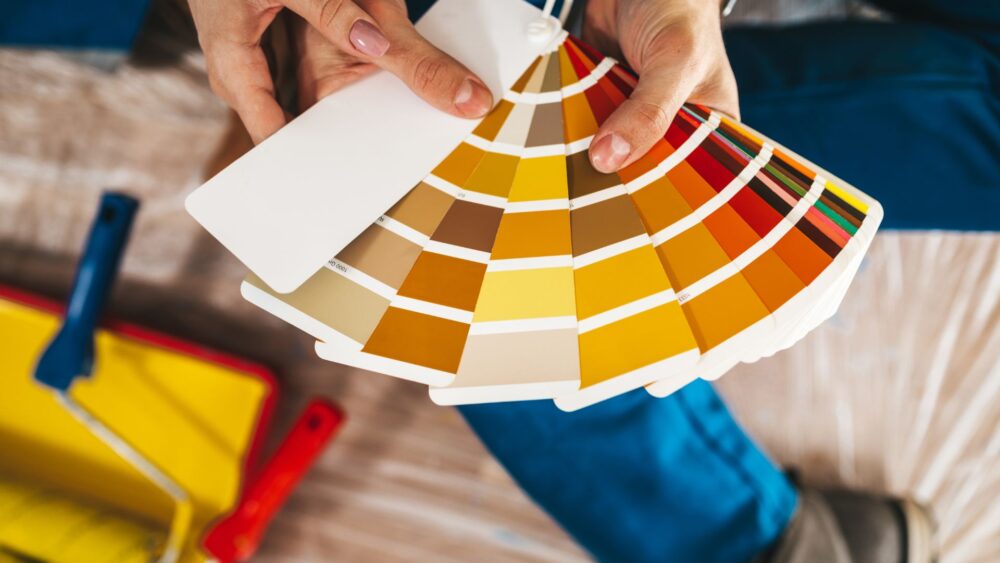Thinking about giving your space a fresh look? The magic of indoor painting can do just that, breathing new life into any room with strokes of genius. Whether you’re eyeing those drab walls thinking it’s time for change or simply in the mood for some color therapy, this guide is your ally. With the right paint and techniques, even the most novice painter can achieve professional results. So let’s dive straight into turning those ideas into reality.
Planning Your Indoor Painting Project
Before you even pick up a paintbrush, there’s some important prep work to do. Believe me when I say, a bit of prep work can really turn your painting project from okay to outstanding.
First things first, let’s talk about lighting. Good lighting is key when you’re painting interior walls. Seeing what you’re working on is crucial, isn’t it?
Setting Up Work Lights
When it comes to painting indoors, proper lighting is a game-changer. You want to set up some bright, adjustable work lights or lamps to really illuminate the area you’re working on.
This way, you can see any imperfections in the wall texture and make sure you’re getting even coverage with your paint. No more missed spots or splotchy walls.
Covering or Removing Large Items
Now, let’s talk about all the stuff in the room. You don’t want to get paint on your furniture or floors, do you? Of course not.
Before you start painting, take the time to cover or remove any large items in the room. We’re talking furniture, rugs, curtains – anything that might get in the way or accidentally get splattered with paint.
You can use drop cloths or plastic sheeting to protect your floors and larger pieces. Believe me, putting in that bit of extra effort now can save you from a world of trouble later on.
Covering or Removing Small Items
Don’t forget about the smaller things too. Those little decor pieces, outlet covers, light switch plates – they all need to be dealt with before you start painting.
You can either remove them entirely or cover them up with some handy painter’s tape. This will save you the headache of trying to scrape paint off your favorite picture frame later on.
Taking a bit of time to prep your space really lays the groundwork for a smoother, more successful painting adventure. It might seem like a lot of work upfront, but trust me, it’ll make the actual painting process so much easier.
So, grab your paint supplies, set up those work lights, and let’s get this room prepped and ready for a fresh coat of interior paint.
Choosing the Perfect Paint Color for Each Room
Now that your space is prepped and ready, it’s time for the fun part – choosing your paint colors. But with so many options out there, how do you know which one is right for each room?
Well, let’s break it down. Different rooms have different functions and vibes, so you want to choose a color that fits the mood you’re going for.
Understanding Wall Texture and Paint Application
But before we get all excited about the latest color trends, let’s have a little chat about wall texture. The texture of your walls can actually impact how the paint looks when it’s all said and done.
Smooth walls tend to show brush or roller marks more than textured surfaces. So, if you’re working with a smooth wall, you might want to opt for a flat or matte paint finish to minimize any imperfections.
On the other hand, if you’ve got some texture going on, a glossier sheen can actually highlight that texture in a really cool way. So, the trick is to really highlight what sets your place apart.
Trending Interior Paint Colors of 2024
Okay, let’s talk trends. What’s hot in the world of interior paint colors for 2024?
According to the experts, we’re seeing a lot of soothing, nature-inspired hues. Think soft greens, warm beiges, and creamy pastels. These hues work magic, weaving a serene and peaceful atmosphere that’s just perfect for your bedroom or living space.
For a bolder look, rich jewel tones are making a comeback. Deep emerald greens, sapphire blues, and even a pop of terra cotta can add some serious drama to a room.
Of course, neutrals are always a classic choice. But in 2024, we’re seeing a shift towards warmer, earthier tones. Think taupe, sand, and even a hint of blush.
Ultimately, the best paint color for each room is the one that speaks to you and fits the overall vibe you’re going for. Don’t be afraid to experiment and have fun with it.
The Process of Painting Your Home’s Interior
Alright, you’ve prepped your space and chosen your perfect paint colors. Now it’s time to actually get painting. But where do you start?
Let’s break down the process of painting your home’s interior, step by step. Trust me, with a little know-how and some patience, you’ve got this.
Applying Primer: When and Why It’s Necessary
First up, let’s talk about primer. Primer is like the unsung hero of the painting world. This handy helper evens out your wall, making sure the paint sticks well and any nicks or stains are out of sight.
So, when should you use primer? If you’re painting a lighter color over a darker one, switching between oil and latex paints, or working with new drywall or wood, primer is definitely your friend.
Sure, it might feel like you’re going the extra mile for something small, but believe me when I say this – that additional step is your ticket to a perfect finish. Plus, it can actually help your paint last longer in the long run.
Painting Ceilings and Walls
Now, onto the main event – painting those ceilings and walls. Here’s a pro tip: start with the ceiling first, then work your way down to the walls. This way, any drips or splatters will land on unpainted surfaces.
For the ceiling, use a roller with an extension pole to make the job easier on your arms and neck. When it comes to the walls, a roller is great for covering large areas quickly, but don’t forget to “cut in” the corners and edges with an angled brush first.
To get an even finish, apply the paint in a “W” pattern, working in small sections at a time. This helps blend the paint and avoid any obvious brush or roller marks.
Painting Cabinets, Doors, and Trims
Finally, let’s talk about those smaller surfaces – cabinets, doors, and trim. For these areas, a small foam roller or brush is your best bet.
The key here is to work in thin, even coats and sand lightly between each one for a super smooth finish. And when it comes to paint sheen, a semi-gloss or gloss finish is ideal for these high-traffic areas. It’s more durable and easier to clean than a flat or matte finish.
When painting doors or cabinets, don’t forget to remove the hardware first and label each piece so you know where it goes when it’s time to reassemble. Trust me, it’s a small step that can save you a big headache later on.
And there you have it – the process of painting your home’s interior, broken down into manageable steps. With a little preparation, the right tools, and some patience, you’ll be well on your way to a beautifully refreshed space.
Remember, the key is to take your time and enjoy the process. So, why not turn up your favorite music, rope in a buddy for some help, and make the whole experience enjoyable? Before you even realize it, you’ll be kicking back, soaking in the pride of your freshly painted walls, marveling at what you’ve accomplished with a bit of paint and some elbow grease.
Indoor Painting FAQs:
What is the best way to paint inside a house?
Start by prepping your space, laying down drop cloths, and taping edges. Then, tackle one room at a time for efficiency.
Which paint is best for indoors?
Low-VOC latex paints are top picks. They’re safer for indoor air quality and easy to clean up with water.
What is best for interior painting?
A satin or eggshell finish works wonders. It’s durable, has a slight sheen, and hides imperfections well.
When not to paint indoors?
Avoid painting when humidity is high or temperatures are extreme. Paint needs stable conditions to dry properly.
Conclusion
Slapping a new coat of paint on your walls is more than just a color swap; it’s your chance to showcase your personal flair and at the same time, boost the value of your home. As we’ve seen today, armed with patience and creativity (and maybe a bit less tape), transforming spaces becomes not just achievable but fun too. If you’re in need of a local pro, you can BOOK NOW using our form.




